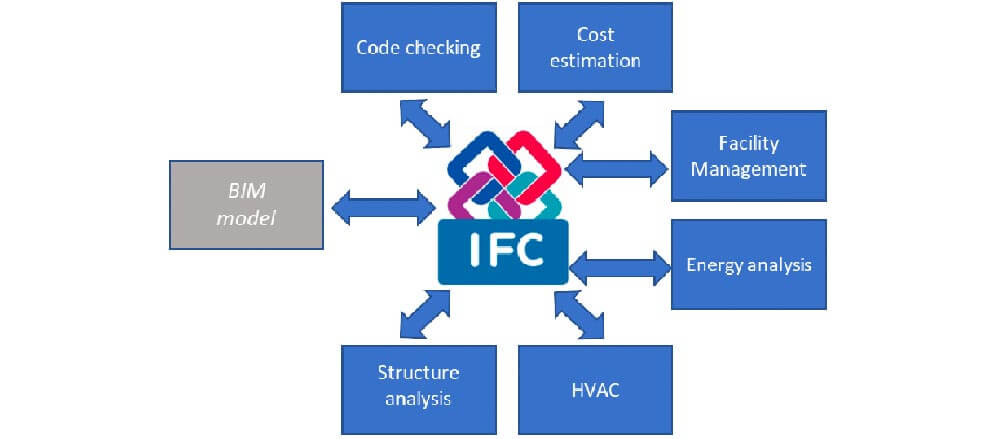The importance of Industry Foundation Classes (IFC) in BIM
Learn how adopting the IFC standard and Building Information Modeling (BIM) will produce significant time and cost saving benefits. This blog looks at what IFC is in relation to BIM and how how the schema can be applied as the industry continues to find ways to be more efficient and effective.
The construction industry is considered by some to be behind other industries when it comes to adopting new technologies and ways of working. There is a drive and need to ensure that people, processes, information, and systems are connected and integrated more effectively.
Achieving this will result in many benefits, including but not limited to, a reduction in total expenditure (TOTEX) for construction projects, enhanced project management capabilities, and the sharing of core information to project stakeholders across the design, construction, and operation phases. Building Information Modeling (BIM) is recognized as a means which will facilitate and encourage these benefits.
What is BIM?
Building information modeling (BIM) is a process supported by various tools, technologies and contracts involving the generation and management of digital representations of physical and functional characteristics of places.
Building information models (BIMs) are computer files (often but not always in proprietary formats and containing proprietary data) which can be extracted, exchanged or networked to support decision-making regarding a built asset.
BIM software is used by individuals, businesses and government agencies who plan, design, construct, operate and maintain buildings and diverse physical infrastructures, such as water, refuse, electricity, gas, communication utilities, roads, railways, bridges, ports and tunnels.
Architecture, Engineering, and Construction (AEC) professionals use BIM processes and tools to make strategic decisions over the course of an asset’s lifecycle (see Figure 1). In 2011, The UK government mandated the use of BIM on all government construction projects by 2016 due to the efficiency and collaboration benefits associated with BIM.

Figure 1 – Design to Demolition of an Asset
When designing and commissioning a built asset, it is important for the various parties involved in this process to transfer information effectively and efficiently between each other. In order to enable and encourage the exchange of information effectively between construction parties, a common exchange schema has been developed which is specifically referred to as Industry Foundation Classes (IFC).
What are Industries Foundation Classes (IFC) and why are they important?
As Architecture, Engineering and Construction (AEC) companies use a variety of software packages to design, commission, and operate assets, there can be difficulties when it comes to the sharing of this data. Primarily, this is due to each software vendor having a file format which is not compatible with other AEC design software packages.
In order to facilitate effective data sharing between AEC parties and asset managers, the IFC schema has been designed. The benefit of using the IFC schema is that information can be shared in a format which enables and encourages interoperability.
Specifically, IFC enables AEC data to be shared among engineers, architects, construction companies, and asset managers. Figure 2 provides an example of some of the data sharing capabilities that are made possible thanks to the IFC schema.

Figure 2 – An example of the interoperability benefits associated with the IFC schema
A neutral file format, such as the IFC schema, is particularly important as information can be shared and exchanged at various points throughout design, construction, commissioning, and operation phases, enabling core stakeholders to have access to data when it is required.
What will this enable?
A standardized approach and methodology for the sharing of construction data will reap significant rewards to the parties involved in the design, build, commissioning, and operation phases. Information sharing, collaboration, integration, and effective communication between all parties will be possible through the adoption and use of one common schema.
For example, the adoption of IFC has seen a lot of success in Finland, where IFC is being used by 60% of Finnish municipalities for submitting planning applications in 3D.2 The benefit of submitting models in the IFC schema is that all core attribute information and data is generated and retained consistently regardless of the author.
This will enable parties involved in the planning process to interrogate, query and raise any benefits or concerns with the building which is to be constructed. A typical benefit of using BIM and IFC for planning applications is the range of simulations which can be tested using the inbuilt capabilities offered by BIM.
What is next for IFC?
The latest IFC schema is being introduced to new industries, specifically bridges, tunnels, roads, rail, and ports. The adoption of the IFC schema will provide and enable significant benefits to those who operate in these industries.
Adopting the IFC standard will produce significant time and cost saving benefits amongst architects, engineers, construction companies, capital project investors and asset managers.
These benefits have been realized in pilot projects where the use of the IFC schema has seen construction projects being delivered ahead of schedule and under budget.
Source: buildingsmart.org
Figure 1 Reference:
Tsumikiseisaku – http://tsumikiseisaku.com/vrox/result/obayashi.html
Lemoniteur – https://www.lemoniteur.fr/article/bim-d-or-2015-decouvrez-les-projets-en-competition.1494729
Figure 3 Reference
Picture Reference : AEC Business – https://aec-business.com/how-bim-is-revolutionizing-building-control-in-finland/

